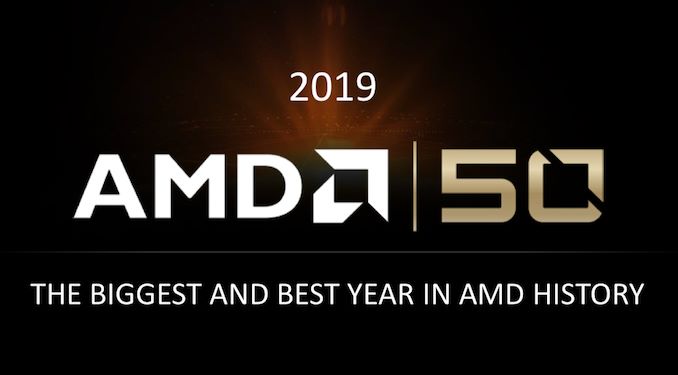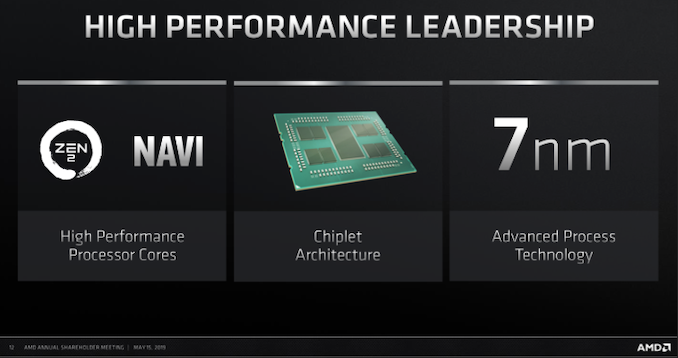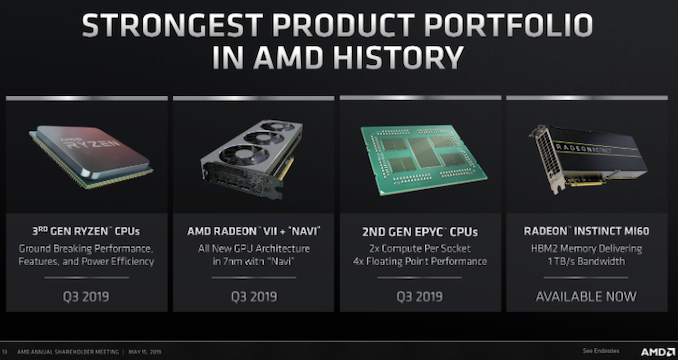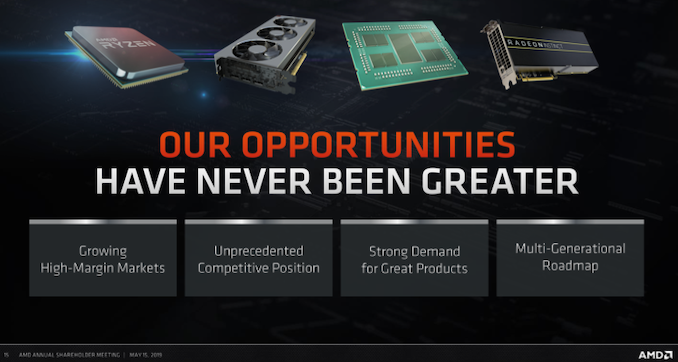AMD Reiterates 7nm Roadmap: Navi, Matisse, & Rome to Launch in Q3
by Anton Shilov on May 17, 2019 8:00 AM EST
AMD this week held its Annual Shareholder Meeting where it reiterated its current technology roadmap and once again confirmed that that its major products set to be released this year based on 7nm will be formally introduced in Q3. Previously the company implied on launch timeframes of its Navi GPU (at least one of them), Matisse CPUs, and Rome server CPUs, but never made a firm promise about the third quarter - this announcement is a commitment to delivering these products in Q3.
The High Level
On a high level, AMD believes that there are four technology pillars that will define its product roadmap in 2019 and forward. These pillars are: the Zen 2 CPU microarchitecture, its Navi GPU architecture, chiplet-based design architecture that enables it to mix and match features and technologies to build a right processor for a given platform, and IP for TSMC’s 7 nm manufacturing technology.
Since R&D processes take years, it was crucial for AMD to make the correct bets when its comes to microarchitecture and fabrication process. That said, this year’s product launches represent a culmination of multi-year efforts by the whole company, but considering that numerous architectural things may be re-used for years, it is important that they have been developed and implemented.
The Products
AMD’s 3rd Generation Ryzen processor, known as Matisse, promises a significant performance increase in general-purpose tasks from where AMD is today. It also adds several new features, such as PCIe 4.0 interface support. Launching this product “shortly in Q3” means that the company wants to make it available already during the important back-to-school season and well ahead of critically important holiday sales season.
Another vital product series for AMD is its next-gen lineup of GPUs based on its Navi architecture. At least one of these graphics processors will be launched in the third quarter. What is noteworthy is that Navi GPUs will coexist with AMD’s Radeon VII graphics cards, which indicates that the latter will continue to serve the enthusiast segment of the market. Furthermore, AMD’s 7nm Vega GPU in the form of the Radeon Instinct MI60 will continue to be offered for high-performance computing workloads.
Also due in Q3 are AMD’s 2nd Gen EPYC processors, known as Rome. These server CPUs are set to feature up to 64 cores powered by the company’s Zen 2 microarchitecture. It is worth keeping in mind that it takes server users some time to adopt new CPUs, and the launch of AMD’s 2nd Gen EPYC in Q3 does not necessarily mean that these processors will be used by a massive amount of designs straight away. Nonetheless, it is still important to release them rather sooner than later in a bid to ramp them up as soon as possible.
One product family worth mentioning is Threadripper. AMD's high-end desktop platform, currently available at 8-32 cores, is expected to be encroached on by the Ryzen 3000 series. AMD briefly held in its roadmaps that Threadripper based on Rome would be coming in 2019, however in its most recent disclosures, that commitment has no longer appeared and AMD has not commented on the matter. It could be that someone made a mistake putting it on the singular slide deck in which it appeared, or there's a level of inconsistency between AMD's presentation teams based on what they are presenting to whom. Hopefully AMD will clarify the matter in due course, and with Computex coming in two weeks, it would be a perfect time to do so.
Related Reading:
- AMD To Host “Next Horizon Gaming” Event & Product Unveil at E3 2019: June 10th, 3pm PT
- AMD: 7nm ‘Navi’ GPU & 'Rome' CPU to Launch in Q3
- AMD's 7nm CPUs & GPUs To Be Fabbed by TSMC, on Track for 2018 - 2019
- AMD Tech Day at CES: 2018 Roadmap Revealed, with Ryzen APUs, Zen+ on 12nm, Vega on 7nm
- AMD Unveils GPU Architecture Roadmap: After Polaris Comes Vega
Source: AMD













55 Comments
View All Comments
lifeguard1986 - Friday, May 17, 2019 - link
"The star was used as an easily identifiable navigational reference point during space missions and American astronaut Virgil Ivan "Gus" Grissom nicknamed the star Navi after his own middle name spelled backwards." -- WikipediaN Zaljov - Friday, May 17, 2019 - link
"Ivan" is Gus Grissom's (he was one of the Mercury Seven and died in the Apollo 1 fire) actual middle name. The names of the stars were intended to be a joke by Gus Grissom:"Several years later, I met with one of the original Mercury astronauts, Wally Schirra, at a conference and, in the course of the conversation, the renamed stars were mentioned as a private joke made by Gus Grissom."
See: https://www.hq.nasa.gov/alsj/a15/a15.postland.html...
Since "Gamma Cassiopeiae" is a kind of pain in the ass-y name to spell and the three stars mentioned were used as navigational reference points, they renamed them for convenience at some point.
TristanSDX - Friday, May 17, 2019 - link
"BEST YEAR IN AMD HISTORY" - let they release these products first. Typically they can't avoid delays and disappointments.'shortly in Q3' - pretty typical behaviour, they release products alt last week(s) of declared quarter
Targon - Friday, May 17, 2019 - link
Or first week of the quarter. May 27th for Computex where AMD will be more specific about specs and launch dates/schedule. If it lands on July 1st, that's technically third quarter, and if AMD said second quarter, that would not be accurate.schujj07 - Friday, May 17, 2019 - link
There have been some theories that AMD will want to launch things on 7/7 since everything will be 7nm.HardwareDufus - Friday, May 17, 2019 - link
That didn't work out well for Boeing on 07/08/2007 (787)…mode_13h - Saturday, May 18, 2019 - link
Except for UK, I'd imagine.https://en.wikipedia.org/wiki/7_July_2005_London_b...
mode_13h - Saturday, May 18, 2019 - link
> Best Year in AMD HistoryMeanwhile, Trump and Xi Jinping have different ideas...
duploxxx - Friday, May 17, 2019 - link
Also due in Q3 are AMD’s 2nd Gen EPYC processors, known as Rome. These server CPUs are set to feature up to 64 cores powered by the company’s Zen 2 microarchitecture. It is worth keeping in mind that it takes server users some time to adopt new CPUs, and the launch of AMD’s 2nd Gen EPYC in Q3 does not necessarily mean that these processors will be used by a massive amount of designs straight away. Nonetheless, it is still important to release them rather sooner than later in a bid to ramp them up as soon as possible.Dear writer , is this your opinion or did AMD tell you this? Zen was a new introduction back into the IT Enterprise world again. Where adoptions were slow and evaluated. ZEN2 is follow up and volume part to regain the market share.
Valantar - Friday, May 17, 2019 - link
That doesn't change the fact that server development cycles are longer than those of consumer products nor that the vendors involved are generally more conservative.